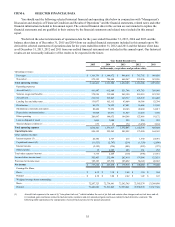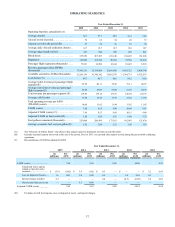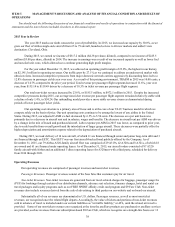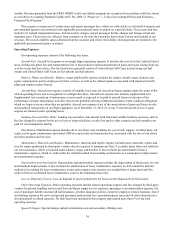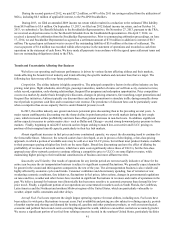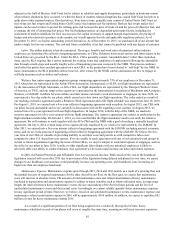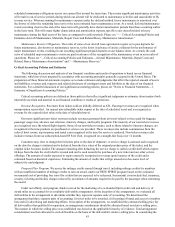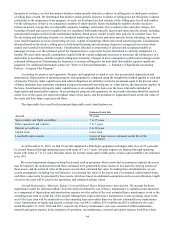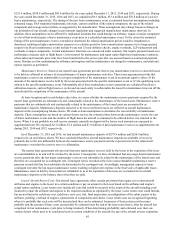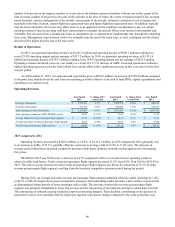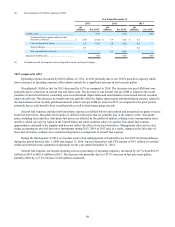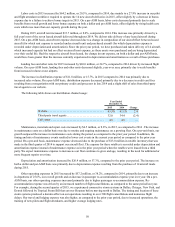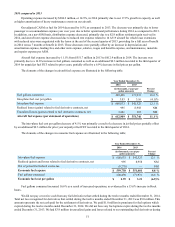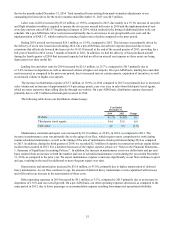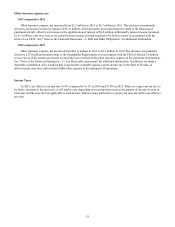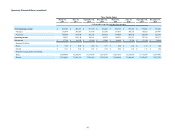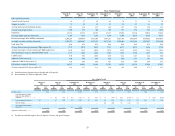Spirit Airlines 2015 Annual Report Download - page 45
Download and view the complete annual report
Please find page 45 of the 2015 Spirit Airlines annual report below. You can navigate through the pages in the report by either clicking on the pages listed below, or by using the keyword search tool below to find specific information within the annual report.45
$123.6 million, $109.8 million and $83.8 million for the years ended December 31, 2015, 2014 and 2013, respectively. During
the years ended December 31, 2015, 2014 and 2013, we capitalized $9.1 million, $33.6 million and $70.8 million of costs for
heavy maintenance, respectively. The timing of the next heavy maintenance event is estimated based on assumptions including
estimated usage, FAA-mandated maintenance intervals, current condition of the related component, the age of the related
component and average removal times as suggested by the manufacturer. These assumptions may change based on changes in
our utilization of our aircraft, changes in government regulations and suggested manufacturer maintenance intervals. In
addition, these assumptions can be affected by unplanned incidents that could damage an airframe, engine or major component
to a level that would require a heavy maintenance event prior to a scheduled maintenance event. To the extent the estimated
timing of the next maintenance event is extended or shortened, the related amortization period would be lengthened or
shortened, resulting in higher amortization expense over a shorter period or lower amortization expense over a longer period,
respectively. Heavy maintenance events include 6-year and 12-year airframe checks, engine overhauls, LLP replacement and
overhauls to major components. Certain maintenance functions are outsourced under contracts that require payment based on a
performance measure such as flight hours. Costs incurred for maintenance and repair under flight hour maintenance contracts,
where labor and materials price risks have been transferred to the service provider, are accrued based on contractual payment
terms. Routine cost for maintaining the airframes and engines and line maintenance are charged to maintenance, materials and
repairs expense as performed.
Maintenance Reserves. Some of our master lease agreements provide that we pay maintenance reserves to aircraft lessors
to be held as collateral in advance of our performance of major maintenance activities. These lease agreements provide that
maintenance reserves are reimbursable to us upon completion of the maintenance event in an amount equal to either (1) the
amount of the maintenance reserve held by the lessor associated with the specific maintenance event or (2) the qualifying costs
related to the specific maintenance event. Substantially all of these maintenance reserve payments are calculated based on a
utilization measure, such as flight hours or cycles and are used solely to collateralize the lessor for maintenance time run off the
aircraft until the completion of the maintenance of the aircraft.
At lease inception and at each balance sheet date, we assess whether the maintenance reserve payments required by the
master lease agreements are substantively and contractually related to the maintenance of the leased asset. Maintenance reserve
payments that are substantively and contractually related to the maintenance of the leased asset are accounted for as
maintenance deposits. Maintenance deposits expected to be recovered from lessors are reflected as aircraft maintenance
deposits in the accompanying balance sheets. We make certain assumptions to determine the recoverability of maintenance
deposits. These assumptions are based on various factors such as the estimated time between the maintenance events, the cost
of future maintenance events and the number of flight hours the aircraft is estimated to be utilized before it is returned to the
lessor. When it is not probable we will recover amounts currently on deposit with a lessor, such amounts are expensed as
supplemental rent. We expensed $2.3 million, $1.6 million and $1.9 million of paid maintenance reserves as supplemental rent
during 2015, 2014 and 2013, respectively.
As of December 31, 2015 and 2014, we had aircraft maintenance deposits of $279.9 million and $250.0 million,
respectively, on our balance sheets. We have concluded that these aircraft maintenance deposits are probable of recovery
primarily due to the rate differential between the maintenance reserve payments and the expected cost for the related next
maintenance event that the reserves serve to collateralize.
The master lease agreements also provide that most maintenance reserves held by the lessor at the expiration of the lease
are nonrefundable to us and will be retained by the lessor. Consequently, we have determined that any usage-based maintenance
reserve payments after the last major maintenance event are not substantively related to the maintenance of the leased asset and
therefore are accounted for as contingent rent. Contingent rent is recorded at the time a non-refundable maintenance reserve
payment is made that has been substantively determined to be contingent rent. Accordingly, management expects to incur
contingent rent after the last major maintenance events resulting in higher rent expense in the final years of applicable leases.
Maintenance reserves held by lessors that are refundable to us at the expiration of the lease are accounted for as aircraft
maintenance deposits on the balance sheet when they are paid.
Leased Aircraft Return Costs. Our aircraft lease agreements often contain provisions that require us to return aircraft
airframes and engines to the lessor in a certain condition or pay an amount to the lessor based on the airframe and engine's
actual return condition. Lease return costs include all costs that would be incurred at the return of the aircraft including costs
incurred to repair the airframe and engines to the required condition as stipulated by the lease. Lease return costs could include,
but are not limited to redelivery cost, redelivery crew cost, fuel, final inspections, reconfiguration of the cabin, repairs to the
airframe, painting, overhaul of engines, replacement of components and checks. Lease return costs are recognized beginning
when it is probable that such costs will be incurred and they can be estimated. Incurrence of lease return costs becomes
probable and the amount of those costs can typically be estimated near the end of the lease term (that is, after the aircraft has
completed its last maintenance cycle prior to being returned). When determining probability and estimated cost, there are
various factors which need to be considered such as current condition of the aircraft, the age of the aircraft at lease expiration,


